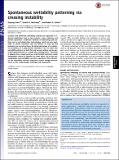Spontaneous wettability patterning via creasing instability
Author(s)
Chen, Dayong; McKinley, Gareth H; Cohen, Robert E
DownloadMcKinley_Spontaneous wettability.pdf (2.577Mb)
PUBLISHER_POLICY
Publisher Policy
Article is made available in accordance with the publisher's policy and may be subject to US copyright law. Please refer to the publisher's site for terms of use.
Terms of use
Metadata
Show full item recordAbstract
Surfaces with patterned wettability contrast are important in industrial applications such as heat transfer, water collection, and particle separation. Traditional methods of fabricating such surfaces rely on microfabrication technologies, which are only applicable to certain substrates and are difficult to scale up and implement on curved surfaces. By taking advantage of a mechanical instability on a polyurethane elastomer film, we show that wettability patterns on both flat and curved surfaces can be generated spontaneously via a simple dip coating process. Variations in dipping time, sample prestress, and chemical treatment enable independent control of domain size (from about 100 to 500 μm), morphology, and wettability contrast, respectively. We characterize the wettability contrast using local surface energy measurements via the sessile droplet technique and tensiometry.
Date issued
2016-07Department
Massachusetts Institute of Technology. Department of Chemical Engineering; Massachusetts Institute of Technology. Department of Mechanical EngineeringJournal
Proceedings of the National Academy of Sciences
Publisher
National Academy of Sciences (U.S.)
Citation
Chen, Dayong, Gareth H. McKinley, and Robert E. Cohen. “Spontaneous Wettability Patterning via Creasing Instability.” Proceedings of the National Academy of Sciences 113, no. 29 (July 5, 2016): 8087–8092.
Version: Final published version
ISSN
0027-8424
1091-6490